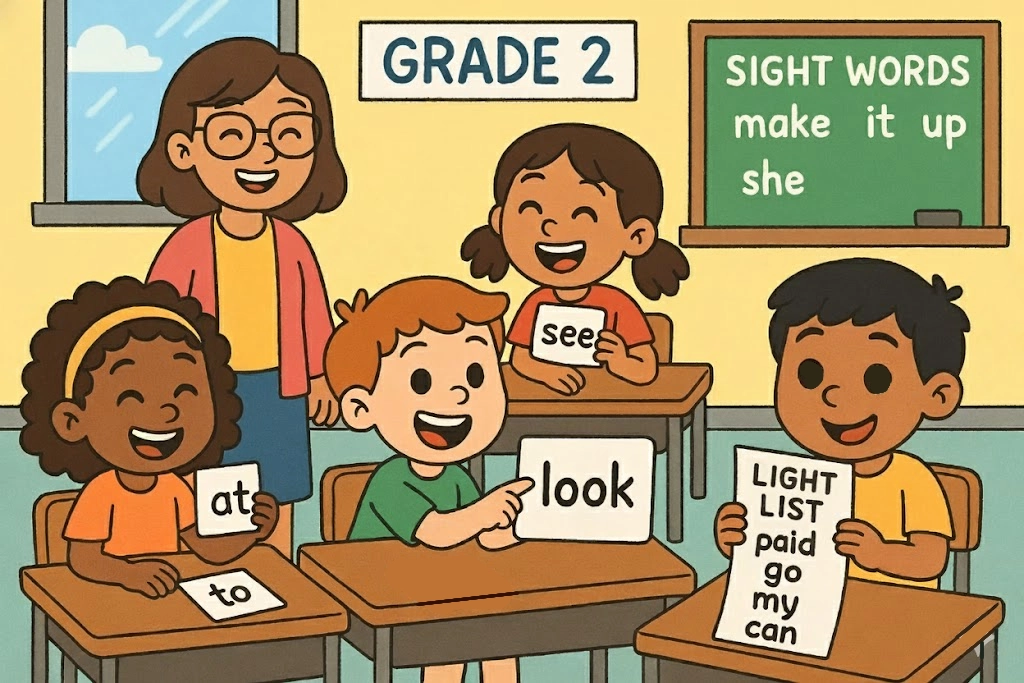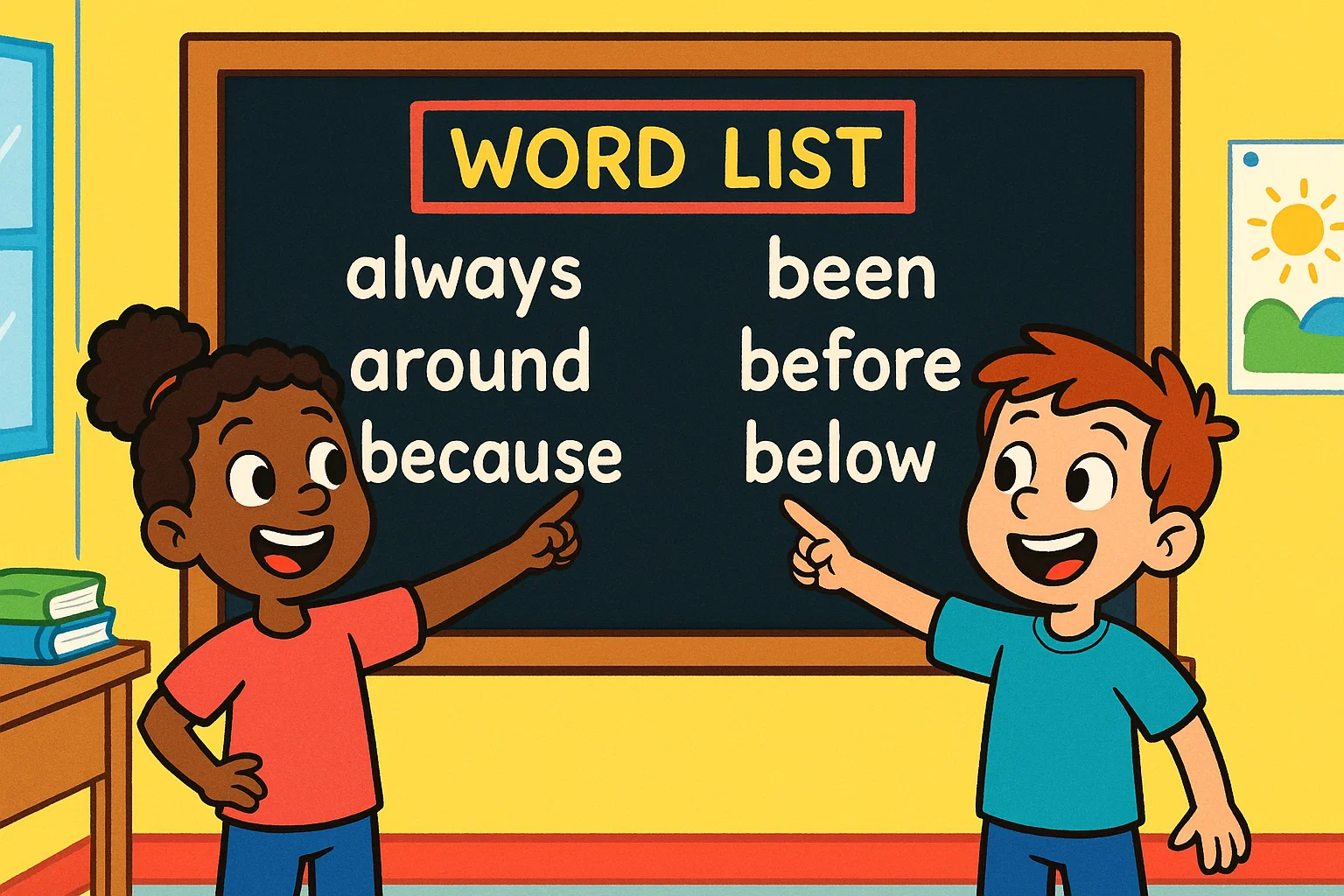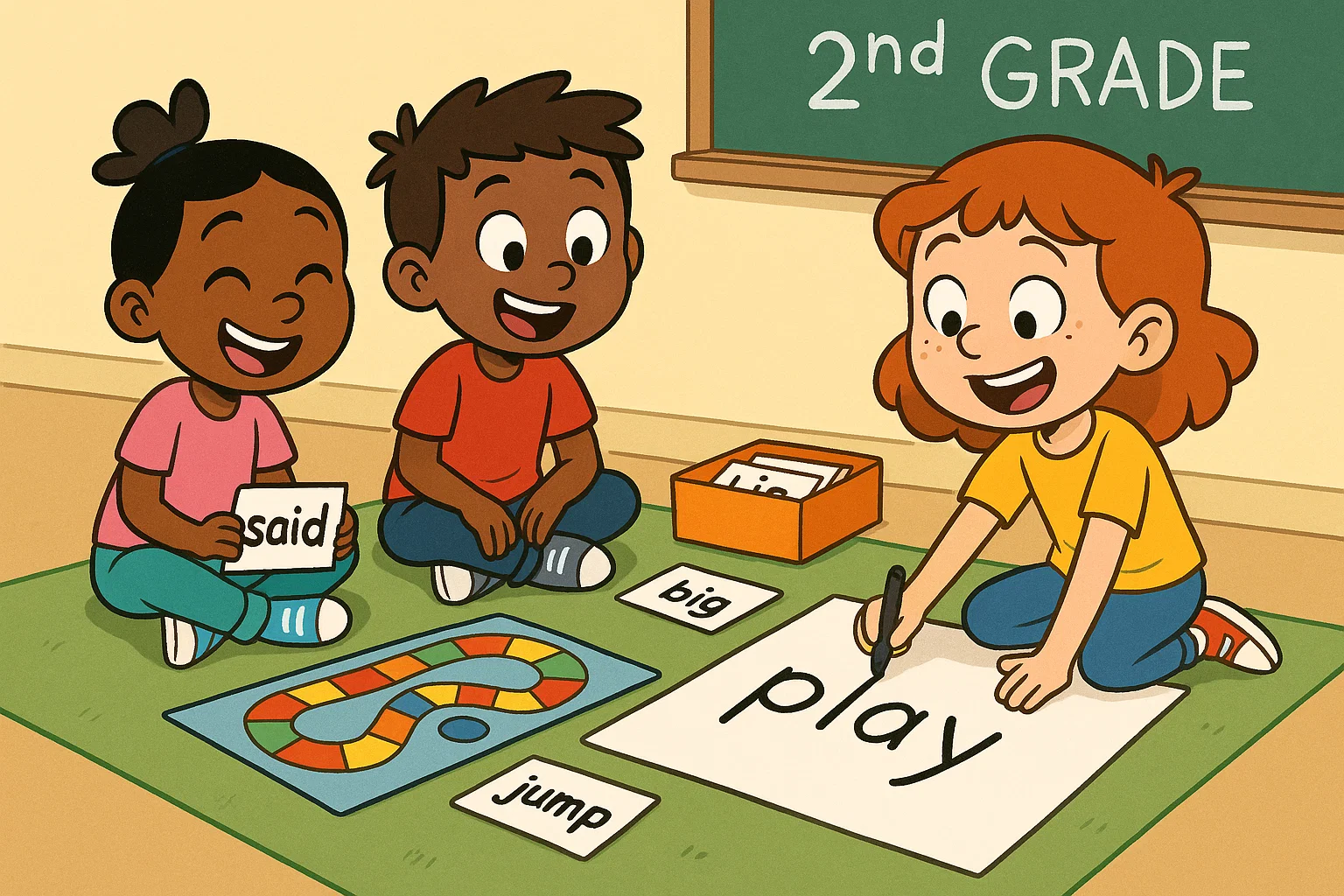Dolch Sight Word Lists for 2nd Grade: Word List, Activities, and Tips to Engage Second Grade Readers

Teaching sight words to your second grader forms the foundation for confident, fluent reading. These high-frequency terms appear in approximately 50-75% of all written text, which means your child will encounter them constantly in books, assignments, and everyday reading materials. When children can recognize these terms without hesitation, they read more fluently and comprehend text with greater ease.
This comprehensive guide provides the complete Dolch sight word lists for 2nd grade, along with practical activities and proven tips to help your child master these essential literacy skills.
Complete Sight Word Lists for 2nd Grade

The foundation of automatic word recognition begins with knowing exactly which words matter most. To effectively support your young reader, you need a reliable, complete set of the most frequent terms they will encounter.
Sight Words for 2nd Grade: The Full Listing
The Dolch list for second grade contains 46 terms that your child should be able to recognize and spell by the end of the school year. These commonly used words often cannot be decoded phonetically, making memorization crucial for reading success.
Complete 2nd-Grade Sight Word List:
| Words 1-12 | Words 13-24 | Words 25-36 | Words 37-46 |
| always | around | because | been |
| before | best | both | buy |
| call | cold | does | don’t |
| fast | first | five | found |
| gave | goes | green | its |
| made | many | off | or |
| pull | read | right | sing |
| sit | sleep | tell | their |
| these | those | upon | us |
| use | very | wash | which |
| why | wish | work | would |
| write | your |
Each entry on this list appears frequently in children’s books and second-grade reading materials. Research from SagePub suggests that mastering these terms can increase reading speed and significantly improve comprehension.
High-Frequency Words for Second Grade: Additional Word Lists
Beyond the Dolch list, many educators incorporate additional high-frequency terms that second graders commonly encounter. These include vocabulary like “about,” “after,” “again,” and “any” from earlier grade levels that some children may still be learning.
Supplementary High-Frequency Terms:
- Vocabulary from 1st grade that needs reinforcement
- Content-specific language from your child’s curriculum
- Terms that appear frequently in your child’s favorite books
- Transition language that helps with sentence comprehension
Practice Sight Words: Creating Custom Word Lists
Creating personalized lists helps your child focus on the specific terms they struggle with. Here’s how to build an effective custom collection:
- Assess Current Knowledge – Have your child read through the complete Dolch list and note which terms they hesitate on or misread.
- Prioritize by Frequency – Focus first on vocabulary that appears most often in your second grader’s reading materials.
- Group by Pattern – Arrange terms with similar characteristics together (those with “th,” entries ending in “y,” etc.) to help your child recognize patterns.
- Keep Lists Manageable – Work with 5-10 new sight words per week rather than overwhelming your learner with too many at once.
- Track Progress – Use a simple chart or checklist to celebrate as your child masters each entry.
The Importance of Learning Sight Words in 2nd Grade

Recognizing these key terms is a vital step, but why does this specific skill hold such immense power over your child’s overall literacy development? The benefits extend beyond simple memorization and directly impact their reading performance.
Benefits of Learning Sight Words for Your 2nd Grader
When your second-grade child learns to recognize sight words automatically, the benefits extend far beyond simple recognition. These advantages include:
Cognitive Benefits:
- Frees up mental energy for comprehension rather than decoding every term
- Builds confidence in reading abilities
- Reduces frustration during independent reading time
Academic Benefits:
- Improves reading fluency rates
- Enhances spelling skills through visual memory
- Supports writing development as children can spell familiar words correctly
Long-term Benefits:
- Creates a strong foundation for 3rd grade literacy demands
- Develops positive attitudes toward reading
- Increases vocabulary acquisition as children read more independently
One parent shared this observation: “Once my daughter could recognize most sight words without hesitation, she actually wanted to read. She wasn’t spending all her energy sounding out ‘the’ and ‘was’ anymore.”
How Sight Words Help Your Child Read Fluently
Reading fluency consists of three components: accuracy, speed, and expression. Sight words directly impact all three areas.
When second graders must decode vocabulary like “because” or “their” phonetically, it interrupts the natural flow of reading. These pauses make it difficult to maintain comprehension and understand the meaning of sentences. Children who can instantly recognize these terms read more smoothly and with better understanding.
For second graders, mastering sight words is the most direct path to achieving this automaticity.
How to Teach Sight Words Effectively
Teaching these essential terms requires a multi-sensory approach that goes beyond simple memorization. Here are evidence-based strategies that work:
Visual Learning:
- Write vocabulary in different colors or sizes
- Create a wall display with commonly used words where your child can see them daily
- Use index cards with the term on one side and a sentence using it on the other
Kinesthetic Learning:
- Have your child trace words with their finger while saying each letter
- Write vocabulary in sand, shaving cream, or on a small whiteboard
- Use magnetic letters to build words
Auditory Learning:
- Spell words aloud together
- Create rhymes or songs that incorporate sight words
- Use each term in multiple sentences to reinforce meaning
The key is repetition without monotony.
Top Sight Word Activities for 2nd-Grade Sight Word Mastery

Rote drilling can quickly lead to boredom and frustration. To keep your child motivated and ensure those essential words stick, we need creative, multi-sensory approaches that turn practice time into playful, engaging experiences.
Ideas to Engage Your Child with Games
Games transform practice from tedious drilling into fun and engaging experiences. These activities help children learn while keeping them motivated:
Scavenger Hunt: Place index cards with sight words around the house. When your child finds a card, they must read the term and use it in a sentence. This gets kids moving while reinforcing recognition skills.
Memory Match: Create pairs of cards with the same sight word written on each. Turn them face down and play the classic memory game. This activity strengthens visual memory and recognition simultaneously.
Bingo: Make bingo cards with different sight words in each square. Call out terms randomly, and your child covers them with markers. The first to get five in a row wins. This game works well for practicing multiple entries at once.
Builder Challenge: Use letter tiles or magnetic letters to build sight words. Time your child to see how quickly they can spell each term correctly. This combines spelling practice with quick recognition.
Roll and Read: Write six sight words on a piece of paper, numbered 1-6. Your child rolls a die and reads the corresponding entry. For added challenge, have them use it in a sentence or act out its meaning.
Tips and Tricks for Practicing Sight Words at Home
Integrating practice into daily routines makes learning feel natural rather than forced. Try these practical tips:
Make It Multisensory: When introducing new sight words, have your child write each term while saying every letter, then read it aloud. This engages visual, kinesthetic, and auditory learning pathways.
Connect to Context: Simply memorizing isolated terms isn’t as effective as understanding how they function in sentences. After your child learns a new entry, immediately show them how it appears in a sentence from their favorite book.
Use Environmental Print: Point out sight words you encounter around the house, on signs, in grocery stores, or while reading together. This helps children understand that these terms are everywhere and useful in real life.
Create Personal Connections: Have your child write sentences using sight words about topics they care about—their pets, favorite games, or family activities. Personal meaning enhances memory retention.
Practice in Short Bursts: Five to ten minutes of focused practice several times daily is more effective than one long session. Brief, frequent practice maintains attention and prevents burnout.
Free Resources: Word Lists and Activities
Numerous free resources can supplement your home practice:
Printable Materials:
- Flashcard templates that you can customize with your child’s specific list
- Worksheet activities that incorporate tracing, writing, and sentence creation
- Game boards designed specifically for sight word practice
Digital Tools:
- Educational apps that provide interactive games
- Online generators that create custom lists based on your child’s needs
- Video resources that teach through songs and animations
Community Resources:
- Local library programs that focus on early literacy skills
- School websites that often provide grade-specific lists and activities
- Parent groups where families share what has worked for their second grader
Effective Tips for Practicing Sight Words at Home
Turning learning into a positive, low-stress daily habit is often the secret to lasting success. Implementing proven strategies for consistent, short-burst practice helps build the automaticity your second grader needs without burnout.
Regular Practice: Making It a Habit
Consistency matters more than intensity when it comes to learning sight words. Establishing a regular routine helps your child develop automaticity through repeated exposure.
Creating a Practice Schedule:
- Choose a specific time each day for practice
- Start with 5-10 minutes and gradually increase as your child builds stamina
- Practice at least 4-5 days per week for optimal retention
- Be flexible—if your child is tired or frustrated, take a break and return later
Building a Routine: Morning practice before school can activate your child’s brain for the day ahead. Alternatively, after-school sessions allow children to decompress first, then engage in focused learning. Find what works best for your family’s schedule and your child’s energy levels.
One teacher observed: “Students who practice sight words for just 10 minutes daily show significantly more progress than those who cram for 30 minutes once a week. Regular exposure is what builds automaticity.”
Using Flashcards and Technology for 2nd Grade Sight Words
Flashcards remain a time-tested tool for mastery, but technology offers new, engaging ways to practice.
Effective Flashcard Techniques:
- Show each card for only 2-3 seconds to encourage quick recognition
- Sort into “know it” and “still learning” piles
- Review the “still learning” pile more frequently
- Mix in mastered entries periodically to maintain recognition
- Have your child spell each term after reading it
Technology Integration: Educational apps can provide immediate feedback and adapt to your child’s learning pace. Many apps incorporate game elements that motivate children to practice longer. However, balance screen time with hands-on activities for a well-rounded approach.
Combining Methods: Use physical flashcards for initial learning, then reinforce with digital practice. The variety keeps your second grader engaged while addressing different learning preferences.
How to Engage Your Child: Stay Positive and Motivated
Your attitude significantly influences how your child approaches practice. Staying positive and motivated creates a supportive learning environment.
Encouragement Strategies:
- Celebrate small victories when your child masters each entry
- Focus on progress rather than perfection
- Avoid comparing your child to siblings or classmates
- Use specific praise: “You read that so quickly!” rather than generic “good job”
When Your Child Struggles: If your child struggles with certain terms, take a step back. Some may be more challenging due to irregular spelling patterns. Break each entry into smaller parts, create a memorable association, or use it in a funny sentence to make it stick.
Maintaining Momentum: Track progress visually with charts or sticker systems. Seeing their accomplishment motivates many children to continue practicing. Let your child choose rewards for reaching milestones—perhaps picking the next book you read together or choosing a fun family activity.
Building Confidence: Confidence grows when children experience success. Ensure your child practices terms they’ve already mastered alongside new ones. This balance provides the satisfaction of fluent reading while gradually expanding their vocabulary.
